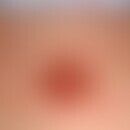HistoryThis section has been translated automatically.
In 1944, Beck used a fascia lata to reinforce an aneurysm for the first time. The first resection of an aneurysm was performed by Cooley et. Al performed the first resection of an aneurysm in 1958 using a heart-lung machine (Frömke 2003).
DefinitionThis section has been translated automatically.
The term "cardiac wall aneurysm" refers to a pathological bulge in the heart wall (Antwerpes 2023).
You might also be interested in
ClassificationThis section has been translated automatically.
A distinction is made between 2 different forms of heart wall aneurysm:
- True aneurysm, which has the following characteristics:
- Proliferation of all layers
- Mostly anterior location
- Paradoxical systolic and diastolic movement (Frömke 2003)
The true aneurysm is more common than the pseudoaneurysm (Rubesch- Kütemeyer 2021).
- False aneurysm (also referred to as "pseudoaneurysm" (Rubesch- Kütemeyer 2021) with typical features such as:
- Mostly posterior, diaphragmatic location
- Risk of expansion
- Risk of free rupture
- Rupture of the ventricle with demarcation as a result of epicardial adhesions (Frömke 2003)
The pseudoaneurysm occurs twice as often after inferior infarcts and is often localized posteriorly, laterally, apically or inferiorly (Rubesch- Kütemeyer 2021).
Depending on their aetiology, cardiac wall aneurysms are differentiated into
- Acutely occurring aneurysm
This is caused by infarct-related necrosis of the heart muscle, as the intracardiac pressure leads to dilatation and thus ultimately to a protrusion of the myocardial wall (Antwerpes 2023).
- Chronic aneurysm (Antwerpes 2023)
The chronic myocardial wall aneurysm develops in the area of the non-contractile infarct scar that is permeated by connective tissue (Antwerpes 2023).
In terms of localization, a distinction is made between:
- Antero-lateral location in the supply area of the RIVA
- Postero-inferior location in the supply area of the RCX and RCA (Frömke 2003)
Occurrence/EpidemiologyThis section has been translated automatically.
A heart wall aneurysm can form in around 20 % of all patients with acute myocardial infarction (Herold 2020). This figure used to be much higher. In times of early revascularization, however, this complication is becoming increasingly rare (Rubesch- Kütemeyer 2021).
EtiopathogenesisThis section has been translated automatically.
Causes of a heart wall aneurysm can be
- Late complication after myocardial infarction
At 20%, this is the most common cause of the development of a heart wall aneurysm (Antwerpes 2023). It usually develops within the first 8 weeks after an infarction (Rubesch- Kütemeyer 2021).
- Chagas disease (Antwerpes 2023)
- Traumatic causes (e.g. previous heart surgery)
- Mycotic infections (Frömke 2003)
PathophysiologyThis section has been translated automatically.
The disturbed ventricular geometry leads to an increase in wall tension and thus to an increase in oxygen consumption. This also disrupts the contractility and function of the ventricle (Frömke 2003).
LocalizationThis section has been translated automatically.
Heart wall aneurysms are localized in up to 85% of cases in the anterior wall apex septum of the left ventricle (Nickenig 2024).
ClinicThis section has been translated automatically.
Clinical symptoms can be:
- Angina pectoris
- Exertional insufficiency
- dyspnea
- Peripheral ischemia
- Ventricular arrhythmias (Frömke 2003)
DiagnosticsThis section has been translated automatically.
ECG and chest X-ray often reveal abnormalities which, together with the symptoms, indicate a heart wall aneurysm. Due to its wide availability, TTE is usually the first diagnostic method, followed by cardiac CT or MRI and possibly also LV angiography (Rubesch- Kütemeyer 2021).
ECG
The following changes may be detectable on the ECG in the case of a heart wall aneurysm
- Pathological Q
- Occasional persistent ST elevation (Antwerpes 2023)
- ST elevation (Herold 2020)
ImagingThis section has been translated automatically.
Transthoracic echocardiography (TTE)
A cardiac wall aneurysm is visualized by:
- Protrusion of the thinned heart wall in both systole and diastole
- Detection of thrombi
- Systolic paradoxical wall movement towards the outside (Antwerpes 2023)
Ventriculography
This can also be used to diagnose a heart wall aneurysm (Kasper 2015).
Complication(s)(associated diseasesThis section has been translated automatically.
The following complications can occur as part of a heart wall aneurysm:
- Reduction of the ejection capacity
- Disturbance of the pumping function
- Cardiac arrhythmia
- Formation of thrombi, as flow anomalies can occur in the area of the aneurysm (Antwerpes 2023)
- Embolism: Embolization of the ventricular thrombi is found in 10 - 15 % (Frömke 2003)
- (Left) heart failure up to cardiogenic shock
- Cardiac tamponade with rupture of the aneurysm (Antwerpes 2023)
The risk of rupture is significantly greater with pseudoaneurysms than with true aneurysms (Rubesch- Kütemeyer 2021).
General therapyThis section has been translated automatically.
An aneurysm can be treated conservatively or surgically, depending on the size, type of aneurysm and severity of the symptoms of heart failure (Rubesch- Kütemeyer 2021).
Internal therapyThis section has been translated automatically.
Conservative therapy includes symptomatic drug treatment (Rubesch- Kütemeyer 2021). No further details were provided in the literature available to me.
Operative therapieThis section has been translated automatically.
If the location of the aneurysm is suitable, it can be surgically removed by aneurysmectomy. Another alternative removal option is the "less invasive ventricular enhancement technique (LIVE)" (Antwerpes 2023).
During the operation, the left ventricle is opened in the area of the aneurysm and all parts of the aneurysm and any thrombi are removed. The aneurysm orifice is then covered with a patch or felt strips (Nickenig 2024).
Progression/forecastThis section has been translated automatically.
With conservative treatment, the 10-year survival rate is 90% for asymptomatic patients and 46% for symptomatic patients (Frömke 2003).
The mortality rate of pseudoaneurysms is 50% if untreated (Rubesch- Kütemeyer 2021).
The heart failure caused by a heart wall aneurysm is associated with an annual mortality rate of 20% (Doenst 2004).
Perioperative mortality is now reported to be only < 10 % (Rubesch- Kütemeyer 2021). The current 5-year survival rates are between 60 - 80 % (Nickenig 2024).
LiteratureThis section has been translated automatically.
- Antwerpes F, Reh F, Thomann J, Engel F, Freyer T (2023) Cardiac wall aneurysm. DocCheck Flexikon. Doi: https://flexikon.doccheck.com/en/cardiac-wall-aneurysm
- Doenst T, Schlensak C, Beyersdorf F (2004) Ventricular reconstruction in ischemic cardiomyopathy. Dtsch Arztebl. 101 (9) A- 570, B- 474, C- 465
- Frömke J (2003) Ventricular aneurysm after infarction - left ventricular aneurysm. In: Standard operations in cardiac surgery. Steinkopff Publishers Heidelberg 27- 30
- Herold G et al. (2020) Internal medicine. Herold publishing house 252, 254
- Kasper D L, Fauci A S, Hauser S L, Longo D L, Jameson J L, Loscalzo J et al. (2015) Harrison's Principles of Internal Medicine. Mc Graw Hill Education 1463
- Nickenig G (2024) Therapie- Handbuch Kardiologie: Das Wichtigste für Klinik und Praxis. Elsevier Urban and Fischer Publishers 74 - 75
- Rubesch- Kütemeyer V, Pula A, Vlachojannis M, Gielen S (2021) The long road to a rare complication of acute myocardial infarction. Cardiology 15 (3) 282 - 285
Outgoing links (8)
Cardiac arrhythmia; Cardiogenic shock; Chagas disease; Dyspnea; Embolism; Heart failure; Left heart failure; Myocardial infarction;Disclaimer
Please ask your physician for a reliable diagnosis. This website is only meant as a reference.




